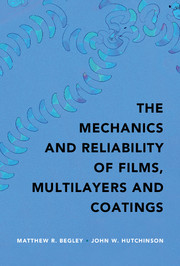Book contents
- Frontmatter
- Contents
- Acknowledgements
- Notation
- 1 Introduction
- 2 Key Mechanics Concepts
- 3 Linear Elastic Fracture Mechanics
- 4 Steady-State Delamination of Bilayers
- 5 Steady-State Delamination in Multilayers
- 6 Steady-State Channeling and Tunneling Cracks
- 7 Crack Kinking from an Interface
- 8 Crack Penetration, Deflection or Arrest?
- 9 Edge and Corner Interface Cracks
- 10 Buckling Delamination
- 11 Delamination of Thin Strips (Patterned Lines)
- 12 Delamination in Multilayers Subject to Steady-State Temperatures
- 13 Cracking under Transient Temperature Distributions
- 14 Software for Semi-Infinite Multilayers: Steady-State Delamination
- 15 Software for Semi-Infinite Multilayers: Transient Delamination
- 16 Finite Element Software for Multilayers: LayerSlayer FEA
- 17 Convergence and Benchmarks with LayerSlayer FEA
- Appendix Asymptotic Crack Tip Displacement Fields for an Interface Crack
- References
- Index
4 - Steady-State Delamination of Bilayers
Published online by Cambridge University Press: 13 July 2017
- Frontmatter
- Contents
- Acknowledgements
- Notation
- 1 Introduction
- 2 Key Mechanics Concepts
- 3 Linear Elastic Fracture Mechanics
- 4 Steady-State Delamination of Bilayers
- 5 Steady-State Delamination in Multilayers
- 6 Steady-State Channeling and Tunneling Cracks
- 7 Crack Kinking from an Interface
- 8 Crack Penetration, Deflection or Arrest?
- 9 Edge and Corner Interface Cracks
- 10 Buckling Delamination
- 11 Delamination of Thin Strips (Patterned Lines)
- 12 Delamination in Multilayers Subject to Steady-State Temperatures
- 13 Cracking under Transient Temperature Distributions
- 14 Software for Semi-Infinite Multilayers: Steady-State Delamination
- 15 Software for Semi-Infinite Multilayers: Transient Delamination
- 16 Finite Element Software for Multilayers: LayerSlayer FEA
- 17 Convergence and Benchmarks with LayerSlayer FEA
- Appendix Asymptotic Crack Tip Displacement Fields for an Interface Crack
- References
- Index
Summary
A significant fraction of the insight and understanding needed to understand mixedmode fracture can be obtained by considering a simple elastic bilayer consisting of two thin layers bonded together, with a semi-infinite crack lying on the interface. The concepts and results generated for the bilayer in this chapter are extended to multilayers consisting of many layers in Chapter 5. Additional aspects of interface fracture in bilayers are discussed throughout subsequent chapters, but notably Chapter 7 (kinking out of the interface), Chapter 9 (finite-sized edge flaws) and Chapter 12 (temperature gradients).
A Basic Solution
A basic solution for a crack on the interface of a bilayer presented in this section illustrates a number of aspects of the mechanics of interface cracks. The solution for the stress intensity factors and energy release to the problem depicted in Figure 4.1 will be presented and applied in this section. The solution was obtained within the context of linear elasticity for an infinitely long bilayer with a semi-infinite crack emerging from the left by Suo & Hutchinson (1990). In this section, we focus on the key results of the bilayer system and their implications: though not shown here, the derivation of the results in this section is identical to that presented in Chapter 5 for a multilayer with many layers.
For the equilibrated load system shown, the stress intensity factors and energy release rate are independent of the position of the crack tip–what is often referred to as steadystate cracking. Within the context of plane stress or plane strain, the energy release rate can be computed exactly using simple energy arguments accounting for the energy difference of the bilayer system far ahead and behind the crack tip. (Here, we focus on the solution for the bilayer and its implications, leaving the underlying derivation for the more general multilayer treatment in Chapter 5.) Determination of the mode mix requires a sophisticated elasticity analysis, which was carried out in the reference cited above and tabulated.
Software accompanying this text generates the full solution for any material combination, using these tabulated values. Alternatively, one can compute the needed results via the finite element code provided with this book, as described in Chapter 16.
- Type
- Chapter
- Information
- Publisher: Cambridge University PressPrint publication year: 2017



